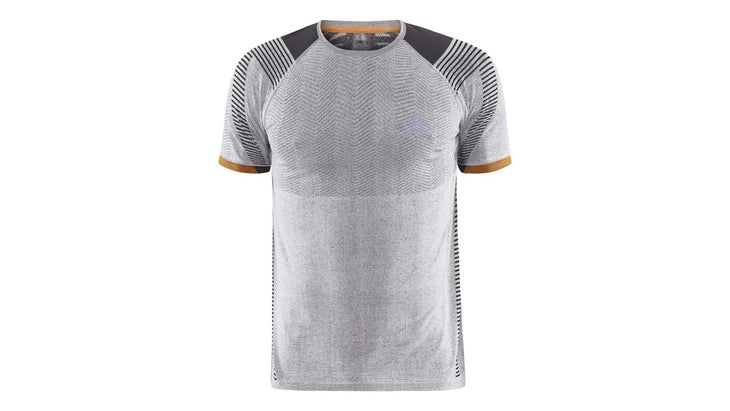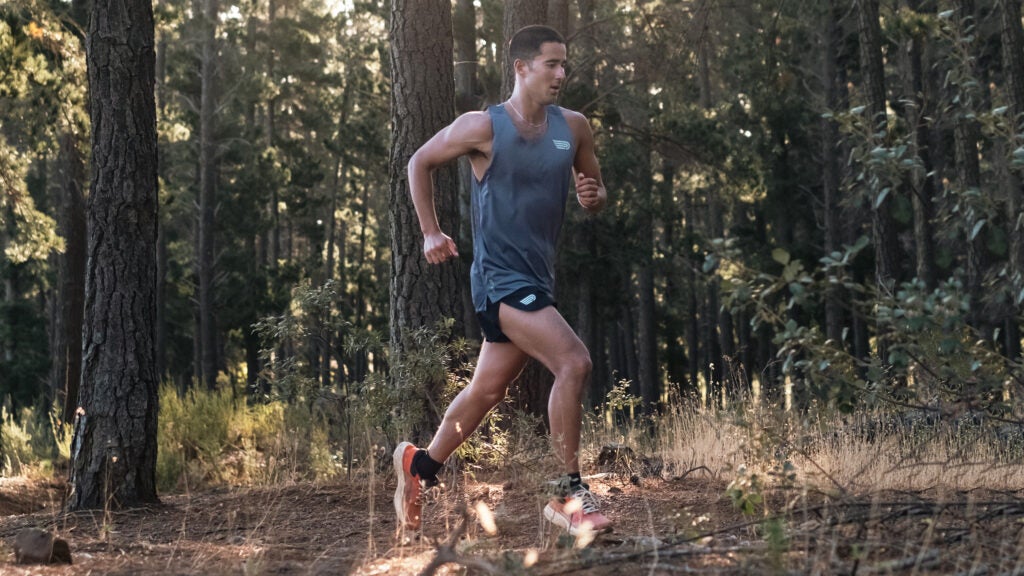No products in the cart.
Outdoor Adventure
The Best Running Shirts for Men (2024)
Summer running can be both amazing (all that daylight!) and challenging (all that sweat!). The right apparel can help you enjoy this special time of year by keeping you cooler and drier while feeling fast and fashionable. We tested 143 hot weather shorts, shirts, singlets, socks, and hats to find the best men’s apparel for your summer runs.
At a Glance
All gear in this guide was tested by multiple reviewers. If you buy through our links, we may earn an affiliate commission. This supports our mission to get more people active and outside. Learn more.
SINGLETS

Best All-Around
Tracksmith Strata Singlet
Sizing: S-XL
Pros and Cons
⊕ Unbeatable heat and moisture management
⊕ Odor resistant
⊗ Costs twice as much as many other well-made singlets
This ultralight marvel is the best singlet I’ve run in during my 40+ years in the sport. The fit is slim but not restrictive, with plenty of stretch. The bluesign-certified nylon/elastane blend incorporates coldblack, a Schoeller Textil technology that reduces heat absorption like nothing else I’ve experienced. As someone who can lose 5 of his 130 pounds on an easy hour run in Maine, I’m used to wringing out gear post-run and leaving large puddles. This simply wasn’t possible when I wore the Strata; although my shorts and socks were drenched, little sweat had collected on the singlet.
And then there’s its odor resistance: I ran at least an hour in it every day without washing it during one of summer’s hottest, most humid weeks. It smelled the same on Day 7 as on Day 1. The Strata is expensive, but a good value, given that owning one eliminates the need for all but maybe one other singlet.

Best Value
Path Projects Andes AD Tank Top
Sizing: S-XL
Pros and Cons
⊕ Highly breathable
⊕ Doesn’t cling
⊕ Good value
⊗ Some prefer wider armholes in hot weather
We valued this tank for its lightness and breathability. “The 90% polyester/10% spandex fabric is woven with an interior texture that reduces the amount of fibers touching the skin, and ventilating holes that let it breathe freely,” one tester said. “It never got soaked and clingy against my skin like most tech singlets. It’s slim-fitting without being tight, so it stays close to the body and out of the way. Plus, it falls just past the waistline, so it isn’t bunching over my shorts.” I also appreciated the wider shoulder straps on trail runs, as a little extra protection against brush snags and bug bites.
Bonus: The Andes costs no more than most run-of-the-mill clingy tops.

Best Airflow
Pressio Elite Singlet
Sizing: XS-XXL
Pros and Cons
⊕ Good wicking and airflow
⊕ Doesn’t cling
⊗ Baggier fit than some prefer
⊗ Too see-through for casual wear
The first time my wife saw me in this piece, she said, “Singlets have really improved.” She’s right. This and many other tops I tested look and perform better than the sleeve-free tubes of cheap polyester I used to wear for summer running. The Elite rose above most because it didn’t cling, even on runs when I sweated so much my shoes squished with every footstep.
The 100% recycled polyester yarn has a micromesh construction in the front and a larger, stretchy (thanks to 9 percent elastane), nearly see-through mesh in the back to maximize airflow. The drape of the cut and lightness of the fabric make chafing more or less impossible. If you haven’t bought a singlet in many years, the Elite will catch you up on innovations.
SHORT SLEEVE SHIRTS

Best All-Around
Walter Sky Merino Tee
Sizing: XS-XXL
Pros and Cons
⊕ Wool softness and odor resistance
⊕ Breathable, non-clinging
⊕ Year-round versatility
⊗ Fabric elongates during longer runs
This shirt’s $75 price tag seems like a lot until you experience its comfort and versatility. “You can both run in it and wear it casually during all four seasons—on its own or as a base layer,” said tester Jonathan Beverly. Innovative Nuyarn construction (70% merino wool/30% nylon) means more merino fibers are exposed to air than in conventionally made merino tops, leading to less moisture buildup and more cooling.
At only 105 grams per square meter, or about two-thirds the heft of many running shirts, it “wicks and breathes excellently and stands away from my skin even when wet,” Jonathan said. It also feels softer than any other lightweight merino tees we have tried, and doesn’t smell even after daily wear for a week. We have made this shirt a mainstay in our year-round running and daily life wardrobes.

Best for Buggy Trails
Craft Pro Trail Running Fuseknit Short Sleeve Tee
$60 at REI $60 at Craft Sports
Sizing: S-XXL
Pros and Cons
⊕ Neck and shoulder coverage
⊕ Lightweight, cool, protects from sun and insects
⊗ Some will want longer sleeves and hemline
Some runners just don’t like singlets. If that’s you, here’s the next best thing. Made of a lightweight recycled polyamide/polyester blend, the shirt hits just below the waist, with sleeves that extend only to the top of the bicep. Textured panels throughout increase airflow and keep the shirt from sticking to sweaty skin. I wore the shirt most often on trail runs during peak bug season—the extra coverage around the shoulders and neck greatly reduced the number of bites I sustained without causing significant heat build-up.

Softest Feel
Paka Men’s Tee
Sizing: XS-XXL
Pros and Cons
⊕ Versatility
⊕ Softness
⊕ Sustainability
⊗ Gets saturated in hot, humid weather
With the advent of technical fibers, most runners started shunning cotton apparel. This shirt, made of a blend of 85% organic pima cotton and 15% royal alpaca fiber, might make you reconsider. It’s pleasingly soft against the skin, which led Nathan and I to use it for both running and daily life. Moisture management is excellent on easy runs in non-oppressive weather. The shirt doesn’t hug even after sweat starts to collect.
Because of the shirt’s versatility and Paka’s sustainability efforts, Nathan picked this tee as the item he’s most likely to buy as a gift for other runners.
What to Look For in Summer Running Apparel
Dressing for summer running is straightforward—you want pieces that breathe, wick moisture, move naturally, don’t stink, and don’t get in the way. Shirt choices come down to how much skin coverage you prefer, fit, and material.
Here are some quick tips on buying the best without going broke:
- Look for high-quality synthetic fibers. Yes, our top picks include a few items with natural fibers. But for the most part, specially designed varieties of polyester, polyamide, nylon, and the like can handle summer running’s high sweat rates better than wool and cotton.
- Seek sun protection. Even if you run at dawn or dusk, or on trails, sun damage can be insidious. Many shorts and tops come with a UPF coating. Well-ventilated hats reduce squinting while shedding heat. Running tan lines aren’t something to be proud of.
- Check for chafing. If you’ve ever been rubbed raw by a rigid seam or sagging liner, you won’t want to repeat the experience. Abrasion accelerates when you’re drenched in sweat. Look for flat seams, unobtrusive logos, and other elements of construction that will minimize chafing.
- Go with the flow. Our picks in this review strike the right balance between being loose enough to allow cooling air flow but not so billowy that they impede normal running form.
- Banish bacteria. Many high-quality summer running items incorporate an anti-bacterial treatment that greatly reduces nasty odors setting up shop. These pieces not only can be worn many more times before needing to be washed, but also lessen your chance of developing a funky skin situation.
- Invest in quality. It can be tempting to think, “Whatever I run in is going to get soaked anyway, so I’ll just buy the cheapest gear out there.” Such reasoning quickly falls apart when, well, the item itself starts to fall apart because of constant exposure to sweat and frequent laundering. Fewer high-quality pieces that hold their form and don’t hold odors are better than more cheaply made gear that will start disintegrating in one summer.
How We Test
- Number of testers: 7
- Number of products tested: 16 singlets, 32 short sleeve tees
- Number of brands tested: 39
- Number of miles run in testing: 3,957
- Highest testing temperature: 97 Fahrenheit
- Highest dew point testing temperature: 78 Fahrenheit
Our testing team ranged across the U.S.—from coastal Maine and western Maryland, to central Wisconsin and the high plains of Nebraska, to the urban bake sites of Chicago and Houston, and, for good measure, the running hub of Eugene, Oregon. All are dedicated runners with average weekly mileage ranging from low 20s to mid 70s. Some have been running for 30 or more years and can compare today’s running apparel to previous attempts to keep runners cool in the summer. We focused on a subjective combination of moisture management, comfort, versatility, value, and looks to answer a simple question: Of all the apparel you logged summer miles in, which would you be most likely to recommend to fellow runners?
Meet Our Lead Testers
Scott Douglas
I’ve run more than 130,000 miles since starting as a teen in the 1970s, and have always loved how daily runs undergird and elevate the rest of my life. As the author or co-author of several running books and a writer/editor about fitness, I’m fortunate to have my personal and professional lives mesh. I sweat like crazy despite living in Maine.
A portion of the trails Scott Douglas ran on regularly while testing running shirts and singlets:
(Gaia GPS is owned by Outside Inc.)
Other testers included:
- Jonathan Beverly, a Nebraska resident who is a senior running gear editor for Outside and has also been running since the 1970s.
- Nathan Brown, a doctor of physical therapy who founded the Pineries Running Lab in Wisconsin.

